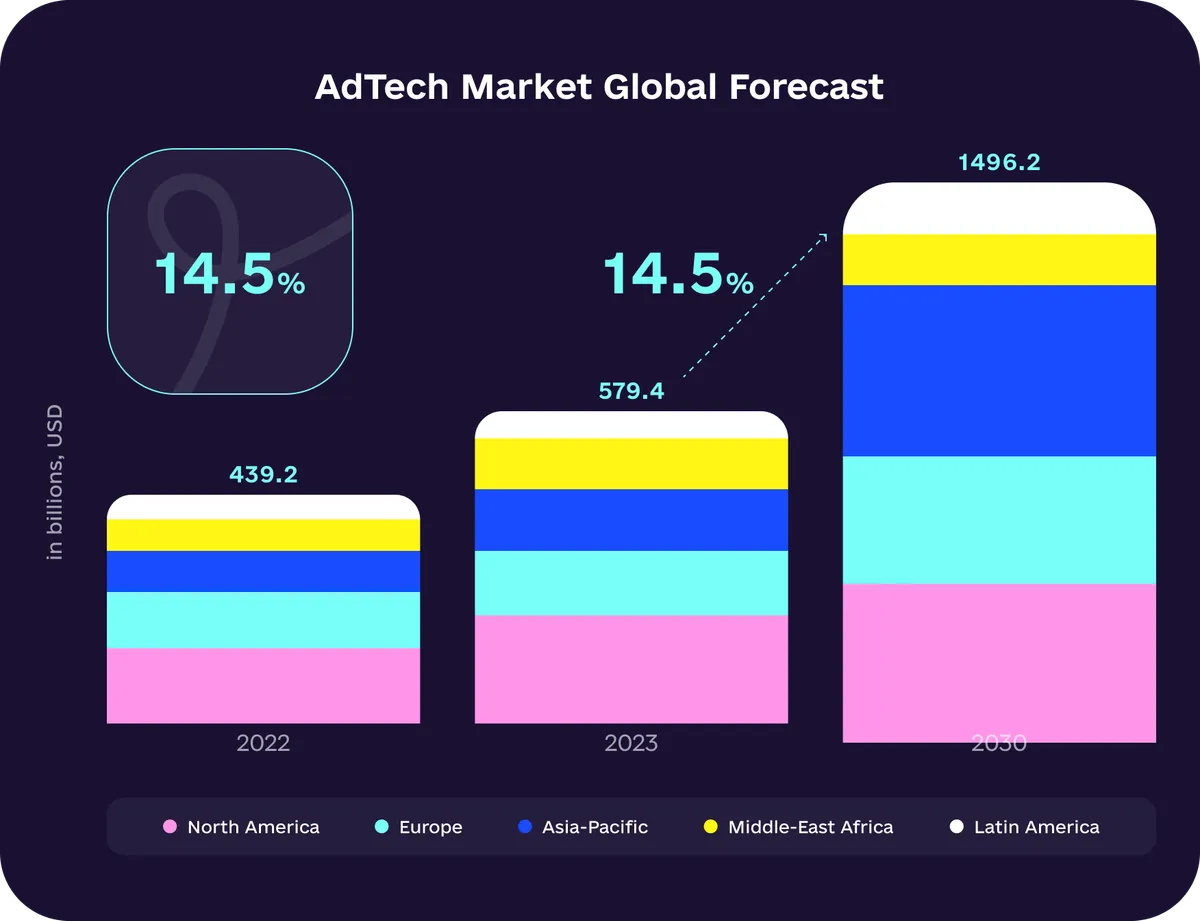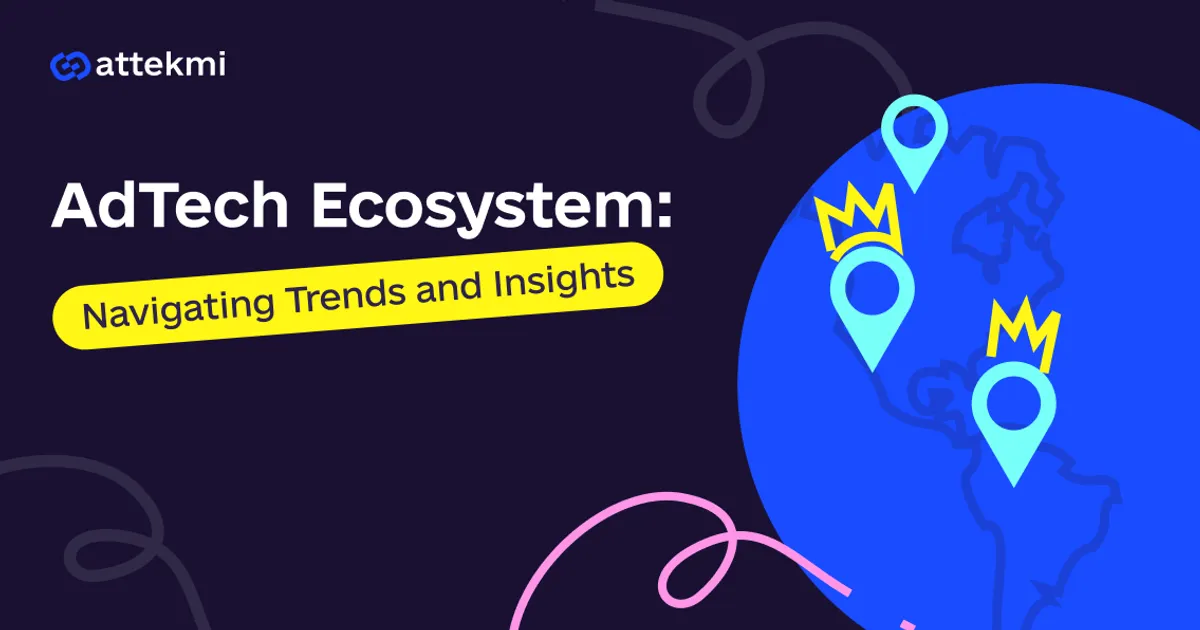AdTech solutions are the main drivers of progress in the digital marketing world today. Therefore, in order to stay at the forefront of technological progress, it is better to follow the AdTech development continuously.
The AdTech market is projected to grow from 579.4 billion USD in 2023 to 1,496.2 billion USD by 2030 at a compound annual growth rate (CAGR) of 14.5% during the forecast period. The market goes up because more and more people are interested in data-driven marketing. Audio ads on streaming and podcasts, along with increased smartphone use for better mobile ads, are also boosting this growth.

In this article, we dive into the dynamic world of AdTech, explaining the structure of the AdTech ecosystem, uncovering its achievements and benefits, and exploring trends. As the lines between adtech and martech continue to blur, understanding both will be crucial to stay ahead of the curve.
Whether you’re a seasoned professional seeking to optimize your advertising strategy or a newcomer looking to grasp the fundamentals, this article is crafted to provide actionable takeaways. Keep reading to learn more about the advertising technology landscape and discover how it can help your business grow.
Key Takeaways
The global AdTech market is projected to grow from $579.4B in 2023 to over $1.49T by 2030, driven by data-driven marketing, mobile usage, and programmatic innovation.
The AdTech ecosystem includes key components: advertisers, publishers, ad networks, DSPs, SSPs, and data management platforms, each playing a vital role in enabling automated, targeted, and measurable advertising.
Major trends shaping 2025 include AI-powered personalization, privacy-first strategies, programmatic refinement, cross-channel integration, voice search optimization, and advertising in the Metaverse.
Advertisers benefit from AdTech by gaining precise targeting, real-time optimization, increased ROI, greater transparency, and scalable campaign flexibility.
Sustainability and inclusive advertising are gaining traction, with brands aligning their messaging with user values and social responsibility.
Attekmi enables businesses to enter the AdTech ecosystem fast, offering ad exchange solutions, custom AdTech development, and expert support. Clients like Roqoon Media and Phonder have already achieved revenue growth up to 262% using Attekmi’s solutions.
AdTech ecosystem: what is it and who is it for?
What is the AdTech ecosystem? AdTech is a complex system of technologies, platforms, and processes that shapes digital advertising. It transforms how businesses engage with their audiences and requires technical expertise to navigate.
We are your trusted partner in any AdTech matter. Contact us to discover how we can help your business grow.
Components of the AdTech ecosystem explained
1. Advertiser
Advertisers are at the forefront of the advertising technology ecosystem, the driving force behind promotional campaigns. Ranging from businesses of all sizes to marketing agencies, advertisers leverage technology to deliver targeted messages to specific audiences, optimizing their reach and impact.
2. Publisher
Publishers play a pivotal role by providing digital real estate where advertisements are displayed. This category includes websites, apps, and other digital platforms that offer spaces for advertisers to showcase their content to a diverse audience.
3. Ad networks
Ad networks act as intermediaries, connecting advertisers with a multitude of publishers. These platforms facilitate the buying and selling of ad inventory across various digital spaces, enhancing the efficiency of ad placements and maximizing exposure.
4. Data management platforms (DMPs)
DMPs are data repositories that collect, organize, and analyze vast amounts of consumer data. Advertisers and publishers leverage DMPs to gain insights into audience behavior, enabling them to create more targeted and personalized advertising campaigns.
5. Demand-side platforms (DSPs)
DSPs empower advertisers to manage and optimize their ad campaigns programmatically. These platforms facilitate the buying of ad impressions in real time, allowing advertisers to reach their target audience more efficiently and at scale.
6. Supply-side platforms (SSPs)
On the other side of the spectrum, SSPs cater to publishers by optimizing the selling of their ad inventory. These platforms enable publishers to connect with a diverse range of advertisers, maximizing the value of their digital spaces.
The AdTech ecosystem, with its diverse array of players and technologies, serves as the backbone of modern digital advertising. As we delve deeper into the intricacies of each component, this exploration will provide clarity for professionals seeking to navigate the complex landscape of AdTech, ultimately empowering them to make strategic and informed decisions in their advertising endeavors.
Key achievements
Programmatic dominance
Programmatic advertising continues to dominate the AdTech ecosystem, with a significant portion of digital ad spending allocated to automated processes. In 2024, global programmatic ad spend reached approximately 595 billion USD, with spending set to approach 800 billion USD by 2028, showcasing its pivotal role in modern advertising strategies.
Mobile advertising prowess
The mobile advertising sector has experienced unprecedented growth, becoming a cornerstone for brands aiming to connect with users on handheld devices. In-app advertising and innovative formats have contributed to a substantial increase in mobile ad spend, accounting for more than half of the total digital ad expenditure.
Data-driven precision
Data-driven advertising has evolved into a powerhouse for personalized marketing. Advertisers leverage sophisticated data analytics, machine learning, and AI to deliver highly targeted and relevant content. The success of data-driven campaigns is evident in the improved engagement rates and conversion metrics.
Video advertising surge
Video advertising has emerged as a dynamic and engaging format, capturing user attention across various platforms. With the rise of short-form video content on social media and streaming services, video ad spending witnessed a surge, reflecting changing consumer preferences.
AdTech ecosystem trends in 2024
As we stand on the cusp of a new year, the AdTech industry continues its relentless pursuit of innovation and effectiveness. The journey through the evolution of AdTech, from its early days to its current state, lays the foundation for a compelling glimpse into the future. The landscape is poised for transformative shifts driven by emerging technologies and strategic adaptations, including supply path optimization, which aims to streamline the path between demand and supply to improve efficiency and reduce costs. Let’s delve into the global AdTech trends that will shape the AdTech ecosystem in the coming year.
1. AI-driven personalization reaches new heights
With advanced AI integration becoming increasingly sophisticated, advertisers are set to unlock unprecedented levels of personalization. Machine learning algorithms will not only analyze historical data but also predict user behavior with greater accuracy, enabling hyper-personalized ad experiences. Advertisers will harness AI to tailor content dynamically, ensuring each interaction resonates with individual preferences.
2. Next-level programmatic advertising
The realm of programmatic advertising is entering a new era of refinement. Real-time bidding (RTB) will evolve with enhanced algorithms, enabling advertisers to make split-second decisions for optimal ad placements. The convergence of programmatic with AI will usher in a level of efficiency and precision that transforms how brands engage with their target audiences programmatically.
3. Privacy-first strategies take center stage
As privacy concerns continue to shape the digital landscape, we can expect a heightened emphasis on privacy-centric strategies. Advertisers will prioritize transparency and user consent, leveraging technologies like differential privacy to glean insights while safeguarding individual user identities. Consent-driven, permission-based advertising will redefine how brands build trust with their audiences.
4. The battle against ad fraud intensifies
While strides have been made in combating ad fraud, we can also expect an intensified effort to eradicate fraudulent activities. Blockchain technology will play a crucial role in securing the transparency of transactions, ensuring that each impression is legitimate. Advertisers will increasingly turn to decentralized solutions to mitigate the risks associated with ad fraud.
5. Seamless cross-channel marketing integration
The silos between different marketing channels will crumble as brands strive for seamless cross-channel ad ecosystem integration. Unified customer experiences will be a focal point, with marketing efforts harmoniously synchronized across platforms. This integration will not only enhance brand visibility but also optimize the customer journey, fostering a cohesive and immersive brand narrative.
6. The metaverse: a new frontier for advertising
The concept of the Metaverse will transcend its gaming origins and become a significant arena for advertising. Brands will explore immersive, interactive ad experiences within virtual environments. Augmented reality (AR) and virtual reality (VR) will be harnessed to create engaging campaigns that bridge the gap between the digital and physical worlds, offering consumers entirely new dimensions of brand interaction.
7. Sustainable advertising practices
With sustainability at the forefront of global concerns, advertisers will increasingly adopt eco-friendly practices. Sustainable advertising will not only become a moral imperative but also a strategic advantage. Brands will seek to align themselves with environmentally conscious consumers by embracing green initiatives, from carbon-neutral ad campaigns to responsible sourcing of creative materials.
8. Voice search optimization takes center stage
As voice-activated devices become ubiquitous, optimizing for voice search will be imperative for advertisers. Brands will invest in creating content that caters to voice queries, and conversational AI will play a pivotal role in crafting natural and engaging interactions between users and brands.
9. Dynamic creative optimization (DCO) reshapes ad content
Additionally, we can expect a surge in the adoption of Dynamic Creative Optimization (DCO), enabling advertisers to deliver personalized and contextually relevant creatives in real time. By harnessing data insights, DCO will dynamically adapt ad content based on user behavior, device type, and other contextual factors, enhancing the overall effectiveness of ad campaigns.
10. Inclusive advertising practices gain momentum
With an increasing focus on diversity and inclusion, advertising will undergo a paradigm shift toward more inclusive content. Brands will champion diversity in their campaigns, reflecting the rich tapestry of global audiences. Inclusive advertising will not only resonate with diverse consumer bases but also contribute to a more equitable and representative media landscape.
Key benefits of AdTech for advertisers
Using AdTech implies multiple opportunities and benefits for advertisers. The main ones are as follows:
Precise targeting. Accurate targeting is key to delivering ads to those users who are most likely to convert and take the desired action. AdTech solutions (like demand-side platforms) are equipped with various targeting and filtering settings that enable advertisers to reach the right users. For instance, you can target customers by language, browser, location, connection type, IAB categories, etc. Applying filters also helps increase the campaign performance.
Improved customer engagement. Modern customers expect personalization, and AdTech tools allow you to create personalized and accurately targeted ads. Such an approach ensures higher relevance of advertisements, which positively affects customer engagement and conversion rate.
Increased ROI. Utilizing programmatic advertising is cost-effective on its own. However, AdTech platforms often have features that allow you to optimize your ad spending, allocate budget more effectively, and, as a result, increase ROI.
Greater transparency. AdTech enables marketers to eliminate unnecessary third parties, prevent ad fraud, and ensure enhanced transparency of the advertising process in general. Additionally, the AdTech analytics track the performance of campaigns, which makes it easy for marketers to detect weaknesses and opportunities.
Ultimate flexibility. With AdTech platforms, advertisers can easily scale their campaigns in response to consumer behavior, trends, or any other factors. The scalable and flexible nature of the AdTech ecosystem enables quick and simple adaptation, which is a great benefit for any business and its marketing strategies.
Consider Attekmi your trusted AdTech partner
Offering a set of ad exchange solutions, Attekmi provides a swift entry into the AdTech ecosystem. By embracing a customer-centric philosophy, we empower businesses to establish and manage their ad exchanges effortlessly. Additionally, you can entrust us with the development of a custom AdTech product.
Our distinctive methodology is designed for specialists, ensuring notable business outcomes with a focus on proactive customer care and dedicated expert support. Attekmi delivers a potent combination of attentive support, expert guidance, and state-of-the-art cost-saving technology, propelling businesses toward remarkable achievements.
With Attekmi, specialists can confidently navigate the intricacies of the AdTech landscape, utilizing our robust platforms to unlock exceptional results. Experience the impact of a customer-centric approach, unparalleled expertise, and advanced technology – all encapsulated in the comprehensive solutions of Attekmi, your gateway to unparalleled success in the AdTech sector.
See how we’ve helped our customers excel:
Feeltapmedia set up an ad exchange in just 7 days, resulting in a 31% ROI and 28% revenue growth in 3 months.
Phonder boosted its revenue by an incredible 87.47% and reached 200K QPS within a year.
Roqoon Media experienced an outstanding 262% revenue surge in a mere 3 months.
Conclusion
The AdTech ecosystem keeps evolving, so we can expect new trends, opportunities, and benefits to enter the stage in the near future. Remaining competitive in the market requires monitoring this evolution, so make sure to keep an eye on the technology advancements – this is especially important for AdTech companies. Doing so enables you to react promptly and adjust your strategies on time to outperform your competitors.
Whether you’re an advertiser, publisher, or tech enthusiast, the AdTech ecosystem beckons with opportunities. Embrace innovation, adapt to change, and uncover the limitless possibilities that lie ahead in this ever-evolving realm. Together, let’s navigate these dynamic waves, shaping the future of AdTech.
Does Attekmi look like the right choice? Let’s talk.
FAQ
How is AI reshaping the AdTech ecosystem?
AI is revolutionizing the AdTech ecosystem by enabling hyper-personalized ad experiences. Advanced algorithms analyze user behavior, predicting preferences with precision. This results in more targeted campaigns, increased engagement, and efficient ad placements. AI is the driving force behind the industry’s evolution, reshaping how businesses connect with their audiences in a rapidly changing digital landscape.
Are there specific global trends impacting the AdTech ecosystem beyond regional boundaries?
Yes, specific global trends transcend regional boundaries in AdTech. Privacy-centric strategies, AI-driven personalization, and the rise of sustainable advertising practices are universally shaping the industry. These trends reflect a collective response to global concerns, ensuring a standardized approach to navigating the complexities of the evolving AdTech landscape.
What challenges and opportunities arise with the globalization of AdTech?
The globalization of the AdTech ecosystem presents challenges in navigating diverse regulatory landscapes and cultural nuances. Advertisers must contend with varied privacy laws and consumer expectations. However, it also offers immense opportunities for expanded market reach, diverse audience targeting, and leveraging innovative technologies on a global scale, fostering new avenues for growth and engagement.
 By Iryna Kozirevych
By Iryna Kozirevych